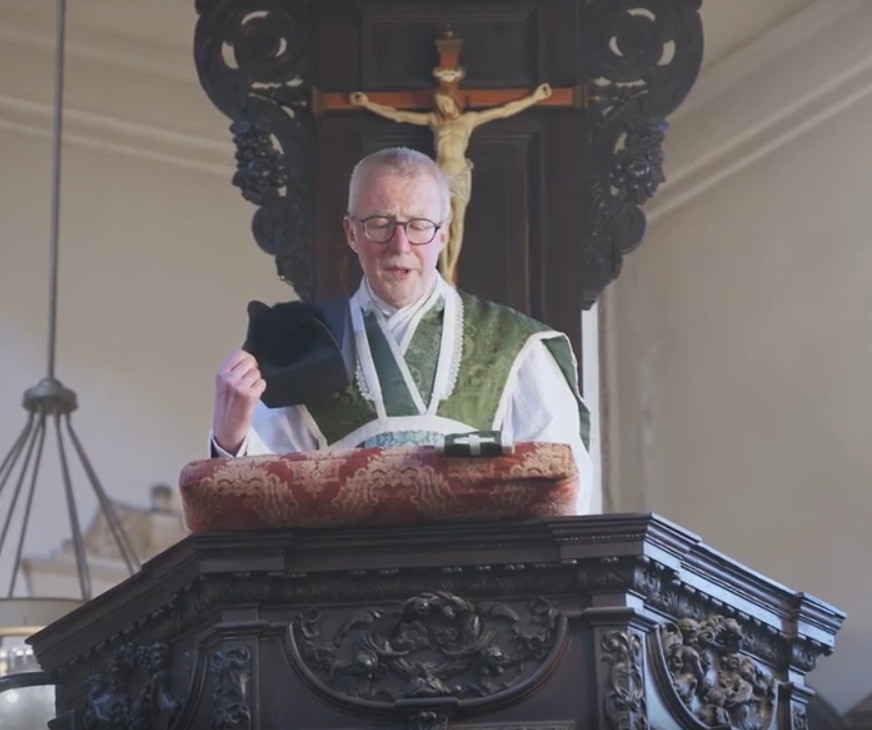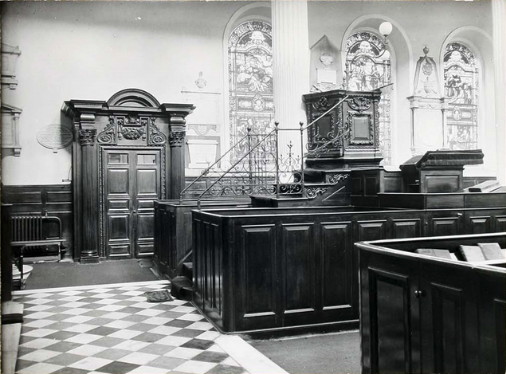Many famous sermons have been preached from the pulpit of St Magnus. In the summer of 1527 Thomas Bilney preached a sermon against images, including the church’s newly-erected rood awaiting gilding. Bilney was arrested after his sermon at St Magnus and was tried for heresy in December 1527. He recanted and was released, but was tried again in 1531 after a relapse into heresy and burned at the stake in Norwich on 19 August (St Magnus Day) 1531. A plaque erected in 1931 to mark the 400th anniversary of his death calls him the “spiritual father of the Reformation in England”.
Miles Coverdale, the translator of the Bible, was Rector of St Magnus in the 1560s. John Hooker (1527-1601), Chamberlain of Exeter from 1555 until his death, worked for Coverdale during the latter’s incumbency as Bishop of Exeter from 1551-53. He gave a description of Coverdale’s last sermon, delivered from the pulpit of St Magnus shortly before his death in January 1569.
Coverdale came at St Magnus church at London Bridge; and being there, the place was void of a preacher. Whereupon certain men of the parish came unto him, and earnestly entreated that considering the multitude was great, and that it was pity they should be disappointed of their expectation, that it would please him to take the place for that time. But he excused his age and infirmities thereof, and that his memory failed him, his voice scarce could be heard, and he not able to do it, that they would hold him excused. Nevertheless such were their importunate requests that … he must and did yield unto their requests: and between two men he was carried up into the pulpit, where God did with his spirit so strengthen him, that he made his last and the best and the most godly sermon that ever he did in all his life. And very shortly after he died, being very honourably buried with the presence of the duchess of Suffolk, the earl of Bedford, and many others, honourable and worshipful personages.
Joseph Caryl, one of the ministers ejected following the Act of Uniformity and 1662 edition of the Book of Common Prayer, gave his farewell sermon at St Magnus on 17 August 1662, taking Revelation 3.4 as his text: “And they shall walk with me in white, for they are worthy.”
I would only say this to you, that as I have from this text, and many more, laboured to bring poor souls into a white state, to a state of justification, to a state of holiness; and as I have been pressing you to keep your garments white, that you may be in the habit of white as your reward; so it shall be the desire and prayers of thy heart, that if I should have no more opportunities among you, that as you have been stirred up to get into this white of grace, that you and I may meet in the white of glory, where we shall never part.

The Wren-period pulpit and tester by the joiner William Grey were restored in 1924 by Martin Travers, who re-erected the sounding board (which had been taken down in 1886) and added a crucifix. The hexagonal pulpit, supported on a stem, has carved angles and raised panels with carved borders on five sides. The lower part of the pulpit is of ogee-section. Below the enriched capping there are segmental panels, three containing wreath and swag and two containing wreaths held by half-cherubs growing out of carved scrolls. The sounding-board is also hexagonal with a carved entablature and cornice. The latter has segmental curves between projecting angles and is surmounted by carved scallop shells, swags and vases. The steps to the pulpit are enclosed by elaborately-decorated iron rails. The pew and reading desk of the original triple-decker pulpit were removed as part of the alterations in 1924.

